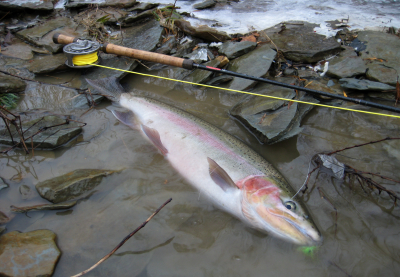
The swung fly technique for catching steelhead is 180 degrees opposite to indicator fishing. We fish an indictor above nymphs and eggs to "indicate" when the fish strikes the flies and to "indicate" whether or not a "dead drift" of the flies through the water's current is achieved. Remember, neither the nymphal stage of an aquatic insect nor an egg has means of independent locomotion in the current. They move from place to place by floating with the current or "dead drifting". Thus the need for mending (manipulating the line in the air or on the water) to reduce or eliminate any "drag" produced from the floating fly line laying across different speed currents and imitate the "dead drift" of the natural food source as it travels down river.
Swinging flies intentionally makes use of the current to INDUCE drag on a floating or sinking line to swing the line and fly across the current in an arc until it comes to rest downstream parallel to the bank. Since swinging flies typically means fishing streamers, which imitate baitfish, the movement of the fly in an arc across the river is essential to mimicking the natural behavior of prey that can swim in the current.
Typically, though not always, when indicator fishing an angler works upstream. When swinging, an angler ALWAYS works downstream casting across and on a downstream angle for each presentation. Indicator fishing targets all the fish in a river. A swung fly specifically targets the more active and/or aggressive fish. So, while indicator fishing has the potential to be more productive, the strike of a fish taking a swung fly can be powerful enough to rip the rod out of angler's hand.
(NOTE: If you're fishing an indicator and come across another angler swinging flies always ask to put in ABOVE them. Never make the mistake of jumping in the river downstream. It's considered extremely poor etiquette).
The recurring high water through the fall and winter has resulted in river flows perfectly suited to catching steelhead using swung fly techniques. (Low water is no good because there is not enough current to swing the line and fly across the river). More than once I've had to cancel clients that wanted to fish indicators because the water was too high, then went out to swing flies on my own. Some anglers will argue that swinging flies in the winter is simply not effective due to cold water and lower metabolism of the fish resulting in less active or aggressive behavior. While it's true that very cold water does limit the number of "players" among the fish already in the river, steelhead are migratory and fresh fish are always moving into the system. It's possible to consistently catch fish on the swing in water temps as cold as 34 degrees, although the catching picks up noticeably once the water temp reaches 36-38 degrees. The bottom line is learning the swung fly technique can increase an angler's number of fishable days on the river.
While it's possible to swing flies with either a single or two-hand rod, anyone who reads this blog with regularity knows I'm a strong advocate of spey casting and using two-hand rods. A couple reasons why I feel the two-hand is superior to the single hand: easier to make long(er) casts in tight conditions; easier to cast sinking tips and turn over larger flies necessary to catch fish in higher flows; distributes the work of casting across more muscles reducing angler fatigue; significantly eases the difficulty casting in the wind; can cast overhead or spey. I find it such a pleasurable and exciting way to fish that when I'm not guiding, I'm almost exclusively swinging flies on the Lake Erie tribs with a two-hand rod.
Don't get stuck inside because you're fishing techniques are limited or you don't have the right equipment. Make lemonade from lemons and learn how to swing flies, put a "switch rod" on your Xmas list and take a spey casting lesson or two. You'll be happy you did!
(NOTE: The most versitile rod for the Lake Erie tribs is a 10.5 to 11 foot 6-8wt "switch rod". A switch rod is a hybrid single and two-hand rod that can be fished with either one or two hands, cast overhead or spey with single hand or spey lines, and handle up to a 10' sink-tip of T14 with a large fly. Occasionally, when the flows are really high then a slightly larger two-hand rod such as a 12.5-13.5 foot 7-8wt rod can be advantageous).
Will Turek
Head Swinger, SAO guide
PS. Midwest Spey School will be offering a Switch Rod specific spey class in the Spring. Check this site for more details or send an email to willturek@midwestspey.com if you're interested in switch rods, spey casting or swung fly techniques.

No comments:
Post a Comment